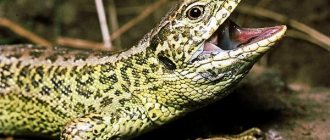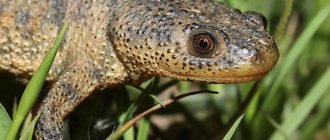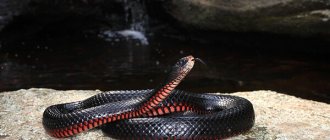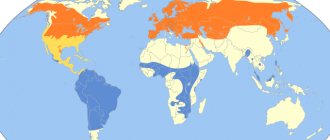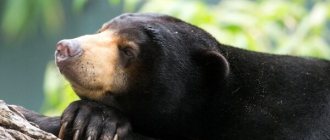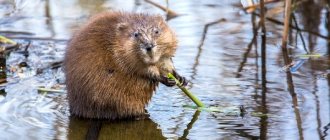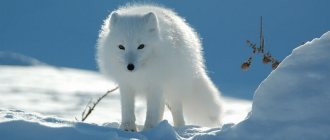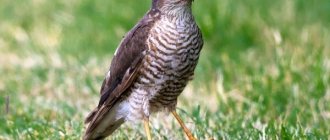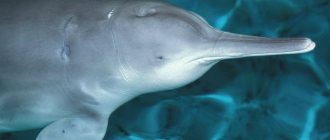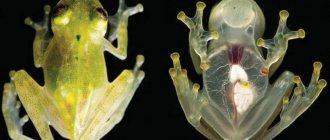- Wild animals
- >>
- Amphibians
The crested newt its name from its long crest that runs along its back and tail. These amphibians are often kept by collectors. In their natural habitat, their numbers are continuously decreasing. The animal looks like a toad or a lizard, but is neither one nor the other. They can live both on land and in water.
Origin of the species and description
Photo: Crested newt
Triturus cristatus comes from the genus Triturus and belongs to the order of caudate amphibians. The subclass unshelled belongs to the class of amphibians.
Newts belong to the following families:
- salamanders;
- salamanders;
- lungless salamanders.
Previously it was believed that the species included 4 subspecies: T. c. cristatus, T. c. dobrogicus, T. c. karelinii and T. c. carnifex. Now naturalists do not distinguish subspecies of these amphibians. The species was discovered in 1553 by the Swiss explorer K. Gesner. For the first time he called it a water lizard. The name newts was given to the genus in 1768 by the Austrian scientist I. Laurenti.
Video: Crested newt
In ancient Greek mythology, Triton was the son of Poseidon and Amphitrite. During the Great Flood, he blew the horn on his father's orders and the waves receded. In a battle with the giants, the god hollowed out a sea shell and the giants fled. Triton was depicted with the body of a man and the tails of dolphins instead of legs. Helped the Argonauts leave their lake and go out to the open sea.
Interesting fact: A representative of the genus has a unique property of regeneration. Amphibians can regenerate lost tails, paws or tails. R. Mattei made an amazing discovery in 1925 - animals can regenerate internal organs and vision even after cutting the optic nerve.
Spreading
Its habitat covers most of the European continent and the western regions of Asia. In the north it reaches Norway, Sweden and Finland, and in the west it reaches France and Great Britain.
The species is widespread in the countries of Central and Eastern Europe. In the south, the boundaries of the range pass through Serbia, Romania, Hungary, Moldova and Ukraine. In Russia, Tristatus cristatus is found mainly in the western part of the country up to Kazakhstan and partly in the Kurgan region in Southwestern Siberia.
The amphibian prefers to settle in lowlands. In mountainous areas it is observed at altitudes up to 700-850 m above sea level.
Today, taxonomists distinguish 4 subspecies based on the color, size and proportions of individual body parts. The most widespread is the nominate subspecies, covering the territory from France to the Urals and from Scandinavia to the Black Sea. It is characterized by an abundance of light spots on the sides and dark spots on the belly.
The subspecies Tc carnifex is distributed in Italy, Austria, Serbia and Montenegro. It is characterized by a smoother skin and large gray spots on the abdomen. In females, a yellow stripe is often visible near the spine.
The subspecies Tc dobrogicus is found in the plain and Danube Delta. It is distinguished by its smallest size in comparison with its closest relatives. It has rough skin that is brown or reddish in color. On the ventral part of the body there are darkish spots in two rows.
Tc karelinii lives on the Balkan Peninsula and southwestern Russia. It is characterized by smooth skin and slight spotting with a bluish tint.
Appearance and features
Photo: Crested newt in nature
The size of adult individuals reaches 11-18 centimeters, in Europe - up to 20 centimeters. The body is spindle-shaped, the head is large and flat. They are connected by a short neck. The tail is flattened. Its length is approximately equal to the length of the body. The limbs are identical and well developed. There are 3-4 thin toes on the front paws, and 5 on the hind paws.
The larvae breathe through their gills. Adult amphibians breathe through their skin and lungs, which are transformed into gills. With the help of a leathery lining on the tail, amphibians obtain oxygen from water. If animals choose a terrestrial lifestyle, it disappears as unnecessary. Newts may squeak, squeak, or whistle.
Interesting fact: Although amphibians have very poor vision, their sense of smell is excellent: crested newts can smell prey at a distance of 200-300 meters.
The species differs from the ordinary newt in the absence of a black longitudinal stripe between the eyes. The upper part of the body is dark with barely noticeable spots. The belly is yellow or orange. There are many clusters of white dots on the cheeks and sides. The throat is dark, sometimes yellowish, with white speckles. The teeth run in two parallel rows. The structure of the jaws allows you to firmly hold the victim.
The skin, depending on the type, can be smooth or bumpy. It feels rough to the touch. On the belly there is usually no pronounced relief, on the back it is coarse-grained. Color depends not only on the species, but also on the habitat. These factors influence the shape and size of the male's dorsal crest, which grows for the mating season.
The height of the crest can reach one and a half centimeters, and the isthmus at the tail has a pronounced isthmus. The most serrated part, extending from the head to the base of the tail. The tail part is slightly pronounced. In normal times, the crest of males is practically invisible.
Varieties:
The crested newt is the largest individual, capable of growing up to 18 cm in length. During the breeding season, a jagged, expressive formation in the form of a crest is formed on the male’s back, giving the animal a resemblance to a dragon. This formation occupies the entire upper part of the body (from the crown to the edge of the tail).
The Asia Minor newt is slightly different from this species
If you do not take into account its smaller size (up to 12-14 cm), the height and jaggedness of its crest is striking. This rather rare species looks slightly menacing and shocking.
The filamentous newt is even smaller in size, its dimensions do not exceed 6 cm
His appearance is softer and more familiar, and his character is less aggressive.
The dwarf newt, which has a second name: fire-bellied, is very extravagant. This term did not arise spontaneously, but due to the bright and catchy red color of the amphibian’s abdomen.
What are the features of their life?
The aquarium newt cannot be called a mystery of nature, but it still has a number of mysterious properties. Having a cold-blooded nature, reptiles prefer the water temperature in the aquarium no higher than 22o. Newt Karelina, for example, is able to reproduce in water with a temperature of 6°C. Therefore, if there is a potential for heating water, for example, from a lamp, a cooling device should be provided.
Triton Karelina
The Iranian newt, which has an indescribable range of color combinations (orange belly, white sides and black back), like many species, likes to bask on the “sunny terrace” equipped directly next to the aquarium. Only with such improvement can a little friend be healthy and beautiful.
Iranian newt
The tailed amphibian marbled newt is interesting. The coloring of its surface allows it to be invisible against the background of silt or dense aquarium vegetation. The bright green intricate pattern on a dark background is a kind of natural mimicry that allows you to adapt to life in an aquarium with predators.
Marbled newt
Where does the crested newt live?
Photo: Crested newt in Russia
The habitat of the creatures is very wide. It includes most of Europe, including the UK, but excluding Ireland. Amphibians live in Ukraine, in western Russia. The southern border runs along Romania, the Alps, Moldova, and the Black Sea. In the north it borders with Finland and Sweden.
They are most often found in forested areas with small bodies of water - lakes, ponds, ditches, creeks, peat bogs, canals. They spend most of their time on the shore, so they find shelter in rotten stumps, mole holes, and the bark of fallen trees.
Animals live on almost all continents, except Australia, Antarctica, and Africa. You can meet them in North and South America, Asia and even beyond the Arctic Circle. The creatures choose places with an abundance of vegetation. Contaminated areas are avoided. In spring and until mid-summer they sit in the water. After reaching land, the creatures hide in shelters.
With the onset of cold weather, amphibians hibernate for 7-8 months and burrow underground, rotten trees, dead wood or a pile of fallen leaves. Sometimes you can see clusters of creatures huddling together. Individuals are better adapted to open spaces. In agricultural areas and populated areas, crested newts are very difficult to find.
The depth of reservoirs is usually no more than one and a half meters, usually 0.7-0.9 meters. Temporary reservoirs may not exceed 0.2-0.3 meters. Animals wake up in the second half of April, when the air warms up to 9-10 degrees. Mass settlement of reservoirs occurs with water temperatures above 12-13 degrees.
Information sources
1. Red Book of the Moscow Region, 2008; 2. Red Book of Orlovskaya..., 2007; 3. Red Book of Lipetsk..., 2006; 4. Bannikov et al..., 1977; 5. Ananyeva et al..., 1998; 6. Kuzmin, Semenov 2006; 7. Litvinchuk, Borkin 2009; 8. Aralov et al..., 1975; 9. Deev 2002; 10. Ryabov, 2006; 11. Shvets, 2007; 12. A.F. Lakomov, Unpublished data; 13. Bulavintsev, 1978; 14. S.A. Ryabov, Unpublished data; 15. O.V. Shvets, Unpublished data; 16. Kuzmin, 1999; 17. Dunaev, 1999; 18. Information from the author of the essay;
on the forum
What does the crested newt eat?
Photo: Crested newt from the Red Book
The diet is different from that on land.
In water, amphibians eat:
- water beetles;
- shellfish;
- small crustaceans;
- mosquito larvae;
- water lovers;
- dragonflies;
- twirlers;
- water bugs.
On land, meals occur less often and in smaller quantities.
Mostly this:
- earthworms;
- insects and larvae;
- slugs;
- empty acorns.
Poor eyesight does not allow it to catch agile animals, so the newt often goes hungry. The lateral line organs help catch amphipods that swim up to the amphibian’s muzzle at a distance of one centimeter. Newts hunt for fish eggs and tadpoles. Mollusks make up about 60% of the diet of amphibians, insect larvae - up to 40%.
On land, earthworms make up up to 60% of the diet, slugs 10-20%, insects and their larvae - 20-40%, small individuals of other species - 5%. In home breeding conditions, adults are fed house or banana crickets, mealworms or earthworms, cockroaches, mollusks and other insects. In the water, the creatures are given snails, bloodworms, and tubifex worms.
Attacks on individuals of their own species, but of smaller sizes, in some areas led to a decrease in the population. On land, amphibians hunt mainly at night or during the day in rainy weather. They catch everything that comes close and fits into their mouths.
Only hatched larvae feed on zooplankton. As they grow older they move on to larger prey. At the larval stage, newts feed on gastropods, caddisflies, spiders, cladocerans, elasmobranchs, and copepods. The creatures' appetite is quite good; they often attack victims larger than their size.
Now you know what to feed your crested newt. Let's see how he lives in the wild.
Who shouldn't have a lizard?
A domestic lizard will definitely not be a good birthday present for a preschooler, a person with an unstable psyche and frayed nerves, or for those who are unable or unwilling to take care of anyone at all. Buying an animal based on the appearance of a lizard in a spontaneous impulse (“Oh, what a pretty gecko!”) will also not end well.
If you do not have the means to keep a lizard, do not torture yourself and it. If you decide that she is the best candidate for the role of your pet, then learn to take care of her from the first to the last day.
We suggest you familiarize yourself with How to properly raise a puppy into a good, obedient dog: secrets of raising a puppy and caring for it
Features of character and lifestyle
Photo: Crested newt
Crested newts begin their activity in March-April, after the ice melts. Depending on the habitat, this process can last from February to May. The creatures prefer a nocturnal lifestyle, but during the mating season they can be active all day long.
Animals are good swimmers and feel more comfortable in water than on land. The tail is used as propulsion. Amphibians move quickly along the bottom of reservoirs, while running on land looks rather clumsy.
After the end of the breeding season, individuals move to land, but some males prefer to remain in the water until late autumn. Although they move on the ground with difficulty, in times of danger the animals can move in quick dashes.
Amphibians can crawl away from bodies of water up to one and a half kilometers. The most confident travelers are young individuals one to two years old. Newts with extensive experience try to settle near water. They do not dig holes for hibernation on their own. Use ready-made ones. They are packed into them in groups to lose less moisture.
At home, amphibians live much longer than in the natural environment. In captivity, where nothing threatens them, newts can live a relatively long time. The oldest recorded individual died at the age of 28 - a record even among centenarians.
Behavior
The crested newt usually begins its activity at the turn of March or April after the ice has melted. Depending on the latitude, this process can occur from February to May.
The animal is nocturnal and can be active all day only during the breeding season. During daylight hours, it hides in thickets of aquatic plants, and with the arrival of dusk it comes out onto land. The amphibian feels more comfortable in water than on the hard surface of the soil. It swims well, using its tail as propulsion.
The diet consists of small crustaceans, mainly ostracods (Ostracoda), snails, leeches (Hirudinea), tadpoles and insects. Adults readily eat amphibian larvae, including their own species. They often attack their smaller newts (Lissotriton vulgaris), which has led, for example, to a significant reduction in their population in Moldova.
After the end of the mating season, most amphibians move completely to land in July and August. Some males refuse to leave the pond and remain in it until September or even late autumn.
Individuals that come onto land hunt at night and during the day during the rains. Their prey is any living creature that fits into their mouths. Repeated cases of cannibalism have been recorded.
Crested newts have a developed sense of smell. They most often detect their prey by smell.
On the ground, amphibians move clumsily and with obvious difficulty, but in moments of danger they are capable of short runs. They can travel up to 1200-1500 m from the reservoir. One- and two-year-old animals are considered the best travelers. Older and more experienced brothers try to settle near the water. They use stumps, fallen trees, rock crevices, mosses, abandoned rodent holes and loose soil as shelters.
Newts hibernate in late October and early November. They overwinter under stones, a thick layer of forest litter, and the roots of trees and shrubs. They do not dig holes on their own, being content with ready-made holes. The most enterprising amphibians spend the winter in damp basements of houses. Hibernation occurs when the ambient temperature drops to zero.
For the winter, crested newts often gather in small groups, which allows them to waste less moisture. Individuals that have been in the water all summer remain there until spring, burying themselves in the silt.
A caught amphibian emits a faint squeak. It can regenerate lost organs. The ability to regenerate weakens with age. The hind limbs and tail recover most quickly.
Social structure and reproduction
Photo: Crested newt in nature
After emerging from hibernation, amphibians return to the body of water where they were born. The males arrive first. If it rains, the path will be easy; if it freezes, getting there will be difficult. The male occupies his territory and awaits the arrival of the female.
When the female is nearby, the male spreads pheromones by actively waving his tail. The gentleman performs a mating dance, trying to charm his beloved, bending his whole body, rubbing against her, lightly hitting her head with his tail. At the end of the process, the male deposits a spermatophore at the bottom, and the female picks it up with the cloaca.
Fertilization occurs inside the body. The female lays white, yellowish or yellow-green eggs approximately 5 millimeters in diameter in late spring and early summer. The eggs are curled in 2-3 pieces into the leaves of aquatic plants. After 14-18 days, the larvae appear. At first they feed on the substance from the yolk sacs, and then they hunt zooplankton.
The larvae are green, the belly and sides are golden. The tail and fin are dark spotted with a white edge. The gills are reddish. They grow up to 8 centimeters in length. Unlike closely related species, they live in the water column, and not on the bottom, so they are often eaten by predatory fish.
Interesting fact: The larvae's forelimbs are the first to grow. The hind ones take about 7-8 weeks to grow.
Larval development lasts about 3 months, after which young individuals emerge from the water onto land. When the reservoir dries out, the process accelerates, and when there is enough water, on the contrary, it lasts longer. The untransformed larvae overwinter in this form. But no more than a third of them survive until spring.
Interesting Facts
Exotic lovers will be interested in interesting facts about the pet:
- If poison was collected from all the skin of a lizard living in South and North America, it would be enough to kill 25,000 small rodents. This amount of poison will be a lethal dose for an adult (male).
- The unique regenerative feature allows the restoration of the tail, paws, internal organs and vision.
- Like chameleons, these newts can change their body color, but not so brightly.
- Due to the fact that amphibians have poor eyesight, they are unable to catch fast living creatures, so they often have to starve.
- Nature has interestingly taken care of preserving the population of crested newts. After the female lays eggs, the babies come to land at the age of 3-4 months. The structure undergoes a number of changes, the gills become an unnecessary organ, and they lose them. If the larvae manage to be born near steep banks, where they are unable to climb to the top to settle on the ground, they retain their gills and continue to live in aquatic conditions without going ashore.
- The proximity of humans to newts has its advantages, since these animals destroy mosquitoes and annoying insects.
- Water is the natural breeding ground for lizards.
- In their natural habitat, lizards choose an ecologically clean place with green vegetation.
- Females lay eggs in curled plant leaves.
Newts are amazing creatures that can restore their body parts and change color, like chameleons.
The animal and its larvae are engaged in the destruction of mosquitoes, which is of great benefit to humans.
The crested newt kills mosquitoes, which is of great benefit to people. In addition, the pet eats carriers of infectious diseases. With proper care, pets will not only become a decoration of the terrarium, but will also be able to reproduce offspring. Young animals should be fed according to all the rules.
Would you like to purchase a crested newt for your own terrarium? Share in the comments!
Natural enemies of crested newts
Photo: Female crested newt
The amphibian's skin secretes mucus and a toxic substance that can infect another animal.
But despite this, newt has many natural enemies:
- green frogs;
- vipers;
- snakes;
- some fish;
- herons;
- storks and other birds.
Sometimes a marsh turtle or a black stork can encroach on the life of an amphibian. Many aquatic predators are not averse to feasting on larvae - some species of fish, amphibians, and invertebrates. Cannibalism is common in captivity. Some populations are greatly affected by introduced fish.
Along with food, parasites that cause pneumonia can enter the animal’s body. Among them: Batrachotaenia karpathica, Cosmocerca longicauda, Halipegus ovocaudatus, Opisthioglyphe ranae, Pleurogenes claviger, Chabaudgolvania terdentatum, Hedruris androphora.
When kept at home, crested newts are susceptible to many diseases. The most common diseases are related to the digestive system. Problems are associated with improper feeding or soil getting into the stomach.
Aquarium specimens often suffer from fungal diseases that affect the skin. The most common problem is Mucorosis. The most common disease is sepsis. This occurs as a result of microbes entering the body. Improper nutrition can lead to the accumulation of fluid in the tissues - dropsy.
Keeping at home
If you really want, you can get a pair of crested newts and start breeding them. It is necessary to take care of the vegetation in the aquarium, constant nutrition and artificial cover in advance.
A reptile needs a special terrarium with a minimum volume of 20 liters. It must be equipped with a lamp and heating. It is necessary to maintain a temperature of about 20 degrees during the day. It is important to consider a landscape that matches the natural habitat conditions and a small body of water.
At home, the creature feeds on insects and worms. Fatty foods or regular foods should not be given to your pet. It is important to promptly dispose of any remaining food in the aquarium.
Population and species status
Photo: Crested newt in water
High sensitivity to water quality is a major factor in the decline in crested newt abundance. The population of this species is declining faster than other amphibians. For T. cristatus, the greatest danger is posed by industrial pollution and drainage of water bodies.
In many areas where amphibians were considered a common species about twenty years ago, they cannot be found now. The crested newt is considered one of the most rapidly disappearing species in the European fauna. Despite its wide range, the species is not at all numerous, especially in the north and east of its usual habitats.
Individuals are scattered mosaically throughout their range and are several times less common than the common newt. In comparison, the comb is considered a background species. Although the crested newt is 5 times smaller in number than the common one, in broad-leaved forests the populations are approximately equal, and in some places even exceed the common species.
Due to massive habitat destruction since the 1940s, the population in Europe has been greatly reduced. The population density is 1.6-4.5 individuals per hectare of land. In places frequently visited by people, there is a tendency to almost completely disappear from large populated areas.
An increase in the road network, the introduction of predatory fish (in particular, sleeper sleeper), destruction by people, urbanization of territories and catching for terrariums negatively affect the number of creatures. Negative factors include the digging activity of wild boars.
Lifestyle
It lives mainly in water, mainly during the breeding season - in shallow reservoirs with stagnant or low-flowing water (ponds, puddles, ditches). Found in parks and river valleys. The species gravitates towards thickets of shrubs in floodplain terraces not far from deciduous and mixed forests. Sometimes newts are found near agricultural land, in gardens and even in vegetable gardens. On land, adult individuals spend the day in the forest floor, under the bark of lying trees, stones and woodpiles, etc. During the day they can be seen only in rainy weather or during the period of migration to breeding grounds.
In the aquatic phase of life, the common newt feeds on small crustaceans, insect larvae, and aquatic mollusks. On land, the main food components are beetles, butterfly caterpillars, centipedes, oribatid mites, spiders and earthworms. The larvae consume daphnia, mosquito larvae and other planktonic invertebrates.
Natural enemies of the common newt are predatory aquatic insects, their larvae, fish, frogs and some species of birds.
Habitat
The species is widespread throughout most of Europe (with the exception of the entire Iberian Peninsula, the south of the Apennine Peninsula, southern France and the northern part of the Scandinavian Peninsula). In the east, the range covers part of Asia up to the Altai Mountains.
It lives mainly in water, mainly during the breeding season - in shallow reservoirs with stagnant or low-flowing water (ponds, puddles, ditches). Found in parks and river valleys. The species gravitates towards thickets of shrubs in floodplain terraces not far from deciduous and mixed forests. Sometimes newts are found near agricultural land, in gardens and even in vegetable gardens. On land, adult individuals spend the day in the forest floor, under the bark of lying trees, stones and woodpiles, etc. During the day they can be seen only in rainy weather or during the period of migration to breeding grounds.
